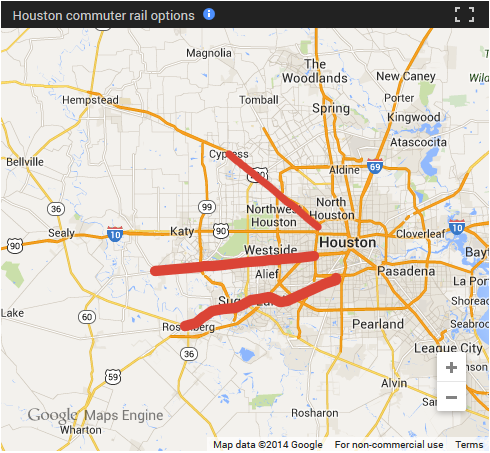There’s still a push for commuter rail in Houston.
With freight trains on Houston area tracks teeming with cargo, supporters of commuter rail to the suburbs are focusing on three spots where they can potentially build their own lines for passengers.
The Gulf Coast Rail District – created in part to find a way to make commuter rail work in Houston – is studying three possible routes for large passenger trains.
What’s clear, at least for the near future, is that commuter trains will not share any track with local freight railroads, or buy any of their land.
“There is a lot of freight moving through the region because of all the new business, and the freight carriers are trying to meet the demand for that,” said Maureen Crocker, executive director of the rail district. “They are not willing to discuss the use of their rail for passenger rail operations.”
[…]
Without access to the freight lines, Crocker said, commuter rail must find its own way. Focusing on land owned by local governments or the state, and near current freight lines, officials identified three possible routes for study: along U.S. 290, U.S. 90A and the Westpark corridor.
The plan is to further study all three, looking at how much ridership they could expect while analyzing the type of property that would have to be purchased, engineering challenges and costly factors such as bridges.
Each of the routes includes some easily obtainable land and could connect suburban commuters to the city. The goal would be to develop commuter rail from the suburbs to Loop 610 – or farther into the central city under some scenarios – and connect it to local transit.
Both the Westpark corridor and U.S. 290 offer close access from western or northwestern suburbs to The Galleria and Uptown areas, where a single bus or light rail trip could carry travelers from a train station to their final destination. The U.S. 90A corridor, which Metro has studied before, offers access from the southwest to the Texas Medical Center.
Developing rail along any of the corridors would pose many challenges. In the case of the Westpark and U.S. 290 routes, both would abut local roads, meaning ramps and entrances would have to undergo serious changes. Other projects, such as light rail and toll roads, also are being considered for the space.
The terrain poses challenges as well. A U.S. 90A commuter rail system would need to cross the Brazos River and would pass by the southern tip of Sugar Land Regional Airport.
“There are challenges out in Fort Bend County,” Crocker said. “But the demand is so high we would like to take another look at it.”
To me, US90A is the clear first choice. I’ve been advocating for Metro to turn its attention back to what it calls the US90A Southwest Rail Corridor (SWRC). As recently as two years ago, they were holding open houses to get community support and finish up a Draft Environmental Impact Statement (DEIS), which would put them and that project in the queue for federal funds. Unfortunately, as of September of 2012, the plans are on hold. I would hope it wouldn’t be too difficult to revive that process, in partnership with the GCRD. Note that while Metro’s original plan for the SWRC stopped at Missouri City, just across the Fort Bend County line, while the GCRD plan goes all the way to Rosenberg. The latter would clearly have much greater ridership potential, and would include destinations that would be of interest outside the regular commute, such as the airport and Skeeters Field. You only get to do this sort of thing right the first time, so it would be best to plan to maximize ridership from the beginning.
As for the other two, it must be noted that the corridors in question are already fairly well served by Metro park and ride. There’s some overlap with the US90A corridor, but not as much. Both Westpark and US90A continue well into Fort Bend County and thus beyond Metro’s existing service area, so I suppose the Westpark corridor would be the next best choice for commuter rail. The other key factor at play here is that the US90A line would connect up with the existing Main Street Line, thus potentially carrying people all the way from Rosenberg and elsewhere in Fort Bend to the Medical Center, downtown, and beyond. The 290 corridor will at least have the Uptown BRT line available to it as a connection, and if it were to happen it might revive discussion of the Inner Katy Line for a seamless trip into downtown via Washington Avenue. As for Westpark, well, go tell it to John Culberson. You know what we’d need to make any Westpark commuter rail line the best it could be. Anything the GCRD can do about that would be good for all of us.

